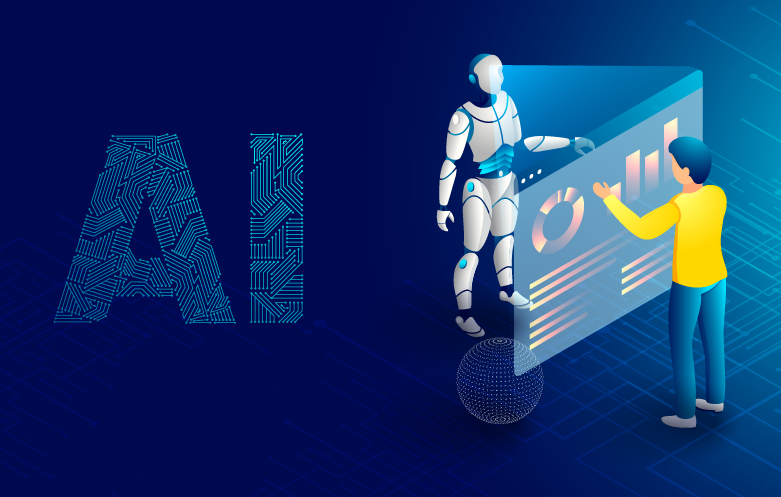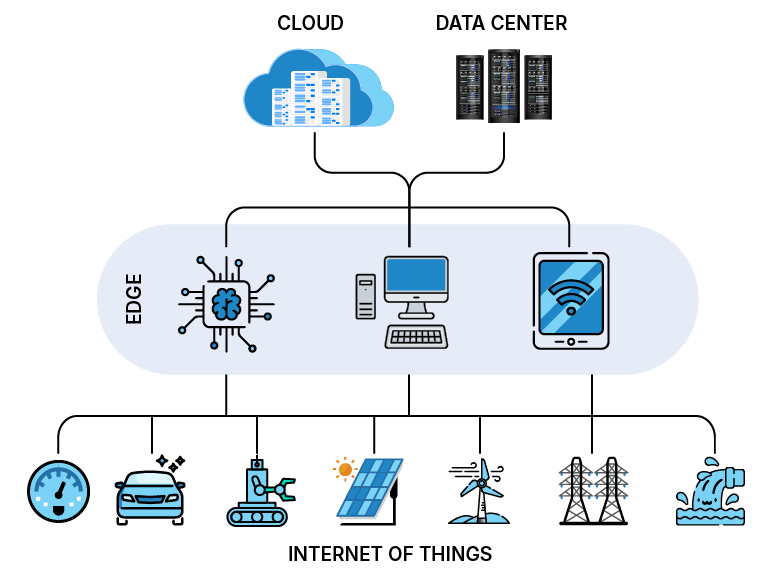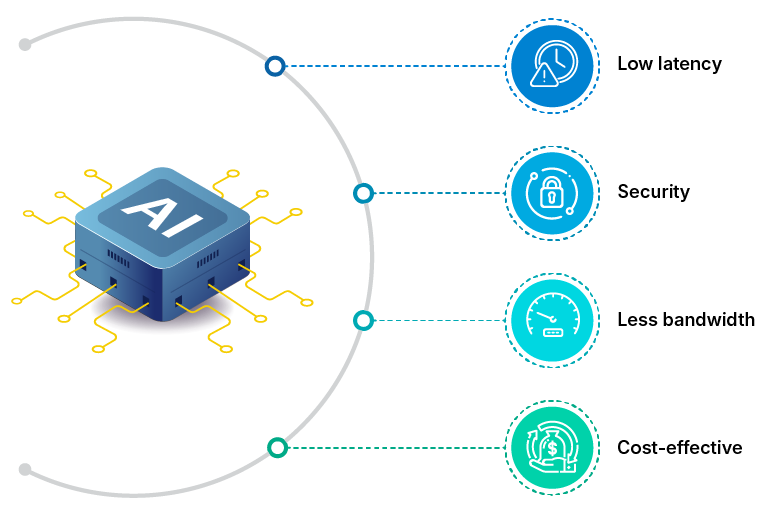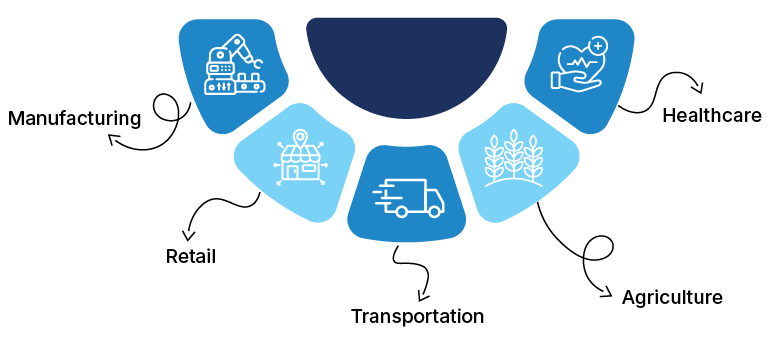

Envision you enter a car, and it automatically adjusts the temperature as you like without even giving the command. While you drive, it guides you by identifying obstacles to keep you safe. Your smartphone understands your voice instantly. Meanwhile, your security system at home identifies anomalies in real time without internet connections.
This is what exactly AI on the edge delivers. You want a device that is more than just connected, you want them to be responsive and intelligent. By processing data locally, edge AI helps you to make real-time decisions that are faster, safer and more efficient.
The question isn’t whether a business should adopt AI on the edge – it’s how fast they can leverage the technology for a competitive edge.
What is AI on the edge?
AI on the edge means integrating artificial intelligence models directly into your devices (edge devices), eliminating the need for cloud servers. These devices can be:
- Industrial machines
- Smartphones
- Cameras
- Smart home gadgets
- Autonomous cars
Instead of sending data to cloud servers to analyze them these devices do the job locally and then sends the data to cloud. These devices specialize in hardware, such as AI chips (e.g., NVIDIA Jetson, Google Edge TPU), to handle tasks like:
- Image recognition
- Speech analysis
- Predictive maintenance
How does AI on the edge work?

To understand the functionality of AI on the edge, let’s explore the key steps involved in its operation:
1. Data collection
Edge devices continuously collect data from cameras, sensors, and other devices, offering a continuous flow of information. This data can range from video feeds to health parameters, audio recordings, and environmental metrics, providing the framework for real-time analysis.
The best example of data collection is your smart phone that tracks your location throughout the day to provide real-time traffic updates and personal recommendations.
2. Data processing
AI models deployed on edge devices process the collected data locally. It analyzes data to predict and extract meaningful insights and detect patterns using AI models without relying on cloud resources.
Local processing ensures decisions can be made quickly, such as autonomous cars deciding which lane to choose while driving to stay safe.
3. Real-time action
Based on the output provided by AI, edge devices can take immediate action. These actions include:
- Identifying anomalies in the process
- Triggering the alarm
- Identifying voice commands
- Detecting irregularities in heart pattern
- Adjusting the path and sending further data to the cloud
This efficiency in acting in real-time is vital in scenarios that require instant responses.
Top benefits of AI on the edge

1. Low latency
Edge AI applications have lower latency as the data is not required to travel to the cloud and back. AI on the edge works best for mission-specific applications such as autonomous cars and remote surgery, which demand lower latency and real-time processing.
With edge computing, data collected from numerous sensors is executed in milliseconds, whereas cloud computing could take a few more seconds.
Thus, edge AI eliminates the speed processing bottlenecks usually occurring with cloud AI.
Why rely on the cloud when your edge devices can think for themselves?
Discover how our AI on the edge brings low-latency, intelligent processing to you! Our SLMs ensure fast, efficient AI that process language without clouds. Find out how we make it possible
2. Security
AI on the edge models boost security and privacy significantly as they eradicate the need to process and transfer data to the cloud by processing the data locally at the edge. As the data is stored and processed locally, there are fewer chances of external parties or malicious actors getting access to sensitive data. Therefore, edge models provide an additional layer of security against data breaches or cyber threats.
3. Less bandwidth
Without edge AI, devices must constantly send data to the cloud, creating bandwidth bottlenecks and increasing costs. This reliance on cloud processing slows down operations and adds latency. However, edge AI minimizes bandwidth consumption by locally handling data storage, management, and processing. It also optimizes network efficiency and enables real-time responses through faster data analysis.
4. Cost-effective
AI-powered cloud services are expensive. Edge AI is a cost-effective alternative as it processes the data locally and sends only essential data for later analysis. This cuts down the cloud workload, optimizes resources, and reduces the need for extensive computing, making AI on the edge a more affordable and smarter solution.
Application of AI on the edge across industries

AI on the edge is revolutionizing industries by enabling real-time decision-making, reducing cost, and automating processes across various sectors.
1. Manufacturing
Edge AI revolutionizes manufacturing processes by proactively identifying anomalies and forecasting machine failure. Equipment sensors anticipate imperfection and notify leaders about the need for repair, preventing operational downtime and offering timely resolutions.
Our experts at Softweb design AI solutions by implementing real-time sensor and data analytics and predictive maintenance that regulates quality control, reduces downtime and enhances product quality.
2. Retail
AI cameras and sensors in checkout-free stores identify products and make payments in real-time, eliminating lines at cash counters. Smart digital displays analyze customer preferences in real-time, offering tailored promotions and product recommendations. Smart logistics systems forecast demand trends and plan delivery routes, minimizing waste and guaranteeing timely replenishment.
At Softweb Solutions, we provide AI-powered analytics that enhance customer satisfaction, manage pricing, and monitor inventory.
3. Transportation
Edge AI is changing the transport landscape by providing real-time traffic management, autonomous vehicles, and predictive vehicle services. Through local data processing, edge AI shortens latency and improves decision-making and resource utilization.
At Softweb, our technical experts offer solutions that improve safety and efficiency for fleet management, autonomous driving, and real-time traffic monitoring.
4. Agriculture
AI on the edge significantly transforms agriculture by continuously monitoring crops, soil, and climatic conditions in real time. AI-equipped drones assess plant health, and smart sensors are used as tools for optimal irrigation and early disease detection. By reducing cloud dependence, edge AI provides high-speed inference, contributes to higher crop yields, conserves resources, and improves general farm efficiency.
5. Healthcare
The healthcare sector is undergoing drastic change by comprehensively applying edge AI to next-generation devices. Wearable health monitors compute health parameters, including heart rate, blood pressure, oxygen saturation, and glucose. Edge AI-powered tools are used in the operating room to assist healthcare providers with essential patient health information. That is, real-time monitoring and diagnostics are beneficial in providing direct-to-remote areas.
Suggested: Edge AI: Crossing the horizon of possibilities in the digital age
AI on the edge: Navigating the technical and security challenges
Although edge AI provides the ability for real-time analysis and facilitates fast decision-making, it also raises certain challenges that must be solved during the implementation.
1. Limited resources
Deploying AI on resource-constrained edge devices requires careful optimization. Limited processing power, memory, and storage make running complex models challenging. Techniques like model quantization (decreasing the precision), pruning (filtering out unnecessary parameters), and knowledge distillation (passing knowledge from larger models) are used to reduce the computational burden and improve performance.
2. Data privacy
Protection of privacy sensitive information at the edge is ensured with strong security measures. Compliance with laws (e.g., GDPR) guarantees privacy and reduces risks. Advanced techniques—such as encryption for data protection, secure boot to prevent unauthorized firmware changes, and trusted execution environments for isolated processing—fortify edge AI against cyber threats.
3. Energy limitations
Power efficiency is a significant concern for battery-operated edge devices. AI models trained to run most efficiently with minimal power consumption result from developer efforts to implement low-power hardware design, optimized AI algorithms, and dynamic power management. These strategies enable long-lasting, high-performance edge computing.
Cloud AI vs. Edge AI: Decoding the battle of intelligence
| Feature | Cloud AI | Edge AI |
|---|---|---|
| Processing location | Centralized, data is processed in remote cloud servers | Decentralized, data is processed locally on the device |
| Power consumption | Higher energy usage due to constant data transmission | Lower energy consumption, optimized for power efficiency |
| Latency | Higher latency due to network delays | Low latency with real-time processing |
| Security & privacy | Data is transmitted to the cloud, increasing security risks. | Data remains on the device, reducing exposure to breaches |
| Computational resources | Access to massive computing power and storage | Limited by device hardware, requiring optimized models |
| Cost | Ongoing costs for cloud storage, bandwidth, and processing | One-time hardware investment, lower operational costs |
| Scalability | Easily scalable with cloud infrastructure | Limited scalability due to hardware constraints |
| Internet dependency | Requires continuous internet connection | Can function offline or with limited connectivity |
| Use cases | Large-scale AI tasks, deep learning model training, cloud-based analytics | Real-time applications like smart cameras, IoT devices, self-driving cars |
Conclusion!
AI on the edge is reshaping how businesses function by enhancing efficiency, driving innovation, and enabling real-time data processing. By optimizing resource utilization, improving security, reducing latency AI on edge inspires businesses to make quick and strategic decisions. As industries integrate this groundbreaking technology, companies leveraging edge AI will secure a competitive advantage, driving new revenue opportunities and enhancing operational efficiency. To remain competitive in the digital landscape, businesses should seamlessly integrate edge AI solutions, ensuring future-ready, scalability and agility.
At Softweb Solutions we perform an in-depth analysis of your existing infrastructure and business goals. We design a custom edge AI solution that aligns completely with your objectives. We also provide constant support to ensure your edge AI systems perform optimally and consistently deliver value.
Is your business prepared for the edge AI transformation? Connect with us today!
Need Help ?
We are here for you